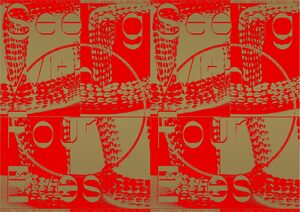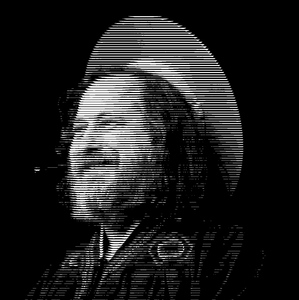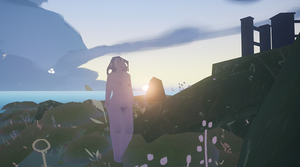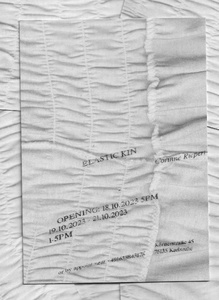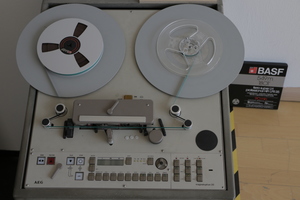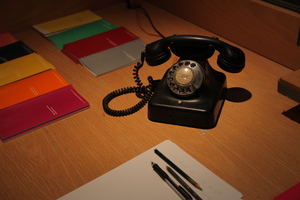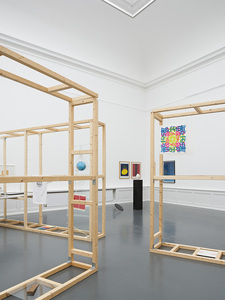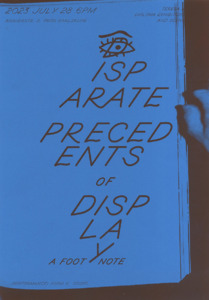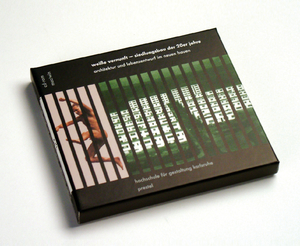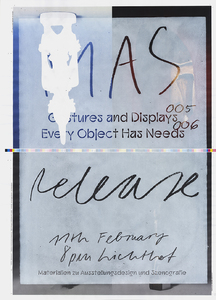Schaufenster Testing
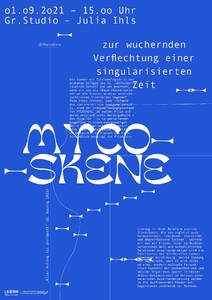
Schaufenster Testing
| Titel |
|
12 Inhalte
- Seite 1 von 1
Geography is destiny
- Titel
- Geography is destiny
- Titel (en)
- Geography is destiny
- Autor/in
- Beschreibung (de)
- In einem bulgarischen Tal, in dem die Produktion von Rosen und Waffen das Klima des Lebensraums bestimmt, begibt sich die Autorin des Films auf eine Identitätssuche, eine Reise entlang der bipolaren, psychogeografischen Realität ihres Geburtsorts.
- Beschreibung (en)
- In a Bulgarian valley where the production of roses and weapons determines the climate of the living environment, the film’s author takes off on an identity quest, a journey along the bipolar, psychogeographic reality of her birthplace.
- Typ des Projekts/Werks
- Schlagworte
- Datierung
- 01.09.2023
- Mitwirkende
- Dank an
- Sprache
- Untertitel (Film)
- Technik/Verfahren/Formate
- dcp
- Dauer
- 75min.
- Ort: Institution
- Ort
- Blauer Salon
- Stadt
- Land
- Bemerkungen
- The film copy will be archived at the Film Archiv of HFG. Current contact person as per 2023 - Philip Lawall
- Titel
- Geography is destiny
- Projektleiter/in
- Semester
- Studiengang
- Typ der Abschlussarbeit
- Importiert am
- 26.09.2023
- Übergeordnete Sets
- 2
- Set enthält
- 0 3
Seeing With Four Eyes
- Titel
- Seeing With Four Eyes
- Titel (en)
- Seeing With Four Eyes
- Autor/in
- Beschreibung (de)
- Die Ausstellung "Seeing With Four Eyes" verfolgt die Objektbiografie der Statue Ngonnso' aus Kamerun durch verschiedene geografische, zeitliche und institutionelle Kontexte. Dieser erste Satz ist bereits fehlerhaft. Ist Statue überhaupt ein angemessener Begriff, um eine Figur zu beschreiben, die für die einen ein Lebewesen darstellt, während andere sie lediglich als Beispiel für materielle Kultur betrachten? Und ist Biografie der richtige Begriff, um das Leben eines Artefakts zu beschreiben? Ist sie an ihr materielles Wesen gebunden oder existiert sie schon lange bevor sie aus Holz geschnitzt wurde und lange nachdem sie von Termiten gefressen wurde oder in einem brennenden Museum verloren ging? In dem Bestreben, mehr über Ngonnso' zu erfahren, beschloss ich, sie bei ihrem Namen zu nennen und damit nicht vorzuschreiben, was sie ist. Ich habe versucht, die Fragmente einer Geschichte zu sammeln, die sich nicht zu einem Ganzen zusammenfügen lassen. Ich verfolgte Fäden, die bis zur Entstehungszeit zurückreichen, zu Strafexpeditionen und Kriegshandlungen des deutschen Kolonialreichs, zu Kulturfesten in Kamerun und Europa und zu einem Museum, das versucht, mit seiner Sammlung zurechtzukommen. Ich habe mit Menschen gesprochen, die sich entweder mit Ngonnso' selbst oder mit den Kampagnen, nationalen Gesetzen und der Politik beschäftigt haben, die sie beeinflusst haben und weiterhin beeinflussen. Ngonnso' befindet sich in einem Schwebezustand: Sie wird im Frühjahr 2019 von einem Museumsdepot am Rande Berlins in eine neue Museumseinrichtung im Stadtzentrum transportiert und damit erneut von einem gelagerten Objekt in ein Ausstellungsobjekt verwandelt. Zugleich ist sie Gegenstand laufender Restitutionsverhandlungen zwischen dem Oberhäuptling des Königreichs Nso', Fon Sehm Mbinglo I, dem Staat Kamerun, dem Ethnologischen Museum Berlin und dem deutschen Staat. "Seeing With Four Eyes" bietet einen Raum, um über diese Einheit in ihren vielfältigen und widersprüchlichen Dimensionen zu reflektieren.
- Beschreibung (en)
- The exhibition "Seeing With Four Eyes" follows the object biography of the statue Ngonnso’ from Cameroon through different geographical, temporal and institutional contexts. This first sentence is already flawed. Is statue even an adequate term to describe a figure that represents a living being to some people, while others merely see it as an example of material culture? And is biography the right term to describe the life of an artifact? Is it bound to its material being or does it exist well before it is carved out of wood and long after it is eaten by termites or lost in a burning museum? In the endeavour to learn more about Ngonnso’, I decided to call her by her name, thereby not predefining what she is. I tried to gather the fragments of a story that do not form a whole. I followed threads that go back to the time of creation, to punitive expeditions and acts of war carried out by the German colonial empire, cultural festivals in Cameroon and Europe, and to a museum trying to come to terms with its collection. I talked to people who have engaged either with Ngonnso’ herself or with the campaigns, national laws, and politics that have influenced and continue to influence her. Ngonnso’ is in a state of limbo: she will be transported from a museum depot in the outskirts of Berlin to a new museum institution in the city centre in the spring of 2019, once again being transformed from a stored object into an exhibition object. At the same time, she is subject of ongoing restitution negotiations between the paramount chief of the kingdom Nso’, Fon Sehm Mbinglo I, the state of Cameroon, the Ethnological Museum Berlin and the German state. "Seeing With Four Eyes" offers a space to reflect upon this entity through its multiple and contradictory dimensions.
- Typ des Projekts/Werks
- Schlagworte
- Datierung
- 14.11.2018 - 16.11.2018
- Sprache
- Ort: Institution
- Ort
- Lichtbrücke
- Stadt
- Land
- Titel
- Seeing With Four Eyes
- Projektleiter/in
- Semester
- Studiengang
- Typ der Abschlussarbeit
- Importiert am
- 24.05.2023
- Übergeordnete Sets
- 3
- Set enthält
- 0 5
Who cares?
- Titel
- Who cares?
- Titel (en)
- Who Cares?
- Untertitel
- Digitale Sozialität, Infrastrukturen der Fürsorge und konviviale Technologien
- Untertitel des Projekts/Werks (en)
- Digital sociality, care infrastructure and convivial technology
- Autor/in
- Beschreibung (de)
- Die Hackerkultur verbindet Theorie und Praxis (nach hand-on Prinzipien) und einen neuen Ansatz für Kulturmaterialien ("information wants to be free"), der nicht nur eine andere Epistemologie, sondern auch einen neuen politischen Diskurs über Digitalität, Geräte und Menschen impliziert. Das Verhältnis zwischen Technik und Politik dieser Gruppe wird im ersten Kapitel analysiert: Zuerst wird die Entstehung proprietärer Software betrachtet, dann die Unterschiede zwischen Open Source und freier Software, und wie im letzten die Privateigentum und die soziale Beziehung zwischen Programmen, Benutzern und Entwicklern radikal in Frage gestellt werden. Später wird diese Beziehung anhand von Hanna Arendts 'Die conditio humana' in Bezug auf Arbeit, Herstellen und Handlen, Notwendigkeit und Freiheit, die die Bedingungen für Politik schaffen, weiter diskutiert. Im zweiten Kapitel wird das Konzept der Konvivialität (Ivan Illich) vorgestellt und diskutiert. Diese Idee wird später in der Wartung als infrastrukturelle Vorsorge weiterentwickelt und als ein zentrales Element digitaler Technologien vorgeschlagen, das weiter diskutiert werden sollte. Diese Konstellation des Denkens und Handelns, des Spielens und Lernens, des Experimentierens und der Übernahme von Verantwortung sowie der Politik und der sozialen Beziehungen sollte in der Technologiedebatte eine wichtige Rolle spielen.
- Beschreibung (en)
- Hacker culture connects theory and praxis (following hand-on principles) and a new approach to culture materials ("information wants to be free"), that implies not only a different epistemology, but also a new political discourse on digitality, devices, and people. The relation between technic and politic of this group is analyzed in the first chapter: first focusing on the emergence of proprietary software; then considering the differences between open source and free software, the last one challenging radically the notion of private property and the social relation among programs, users, and developers. Later on, reading Hanna Arendts 'The Human condition, the relation will be further discussed in terms of labor, work and action, necessity and freedom, which establish the conditions for politics. In the second chapter, the concept of conviviality (Ivan Illich) is introduced and discussed. This idea is later developed in maintenance as infrastructural care and proposed as a central element of digital technologies that should be further discussed. This constellation of thinking and acting, playing and learning, experimenting and taking responsibility, as well as politics and social relations should play a prominent role in the debate about technology.
- Kategorie
- Typ des Projekts/Werks
- Schlagworte
- Datierung
- 30.03.2023
- Sprache
- Titel
- Who cares?
- Projektleiter/in
- Semester
- Studiengang
- Typ der Abschlussarbeit
- Importiert am
- 30.11.2023
- Übergeordnete Sets
- 5
- Set enthält
- 0 4
Vakna
- Titel
- Vakna
- Titel (en)
- Vakna
- Untertitel
- Der menschliche Körper. Das Wiederentdecken. Das Akzeptieren. Das Erwachen
- Autor/in
- Beschreibung (de)
- Der menschliche Körper.
Das Wiederentdecken.
Das Akzeptieren.
Das Erwachen.
Diese Gedanken sind der Beginn des Spiels Vakna, einer Gedankenwelt, die sich mit der Wahrnehmung und der Akzeptanz des unbekleideten menschlichen Körpers befasst und dadurch gesellschaftliche Einflüsse hinterfragt.
In dieser Gedankenwelt ist es dem/der Spieler/in möglich durch auffindbare Fragen und Aussagen mehr über sich selbst, die eigene Wahrnehmung, das eigene Verhalten, die eigene Moral und die eigenen rituellen Gedankengänge den menschlichen Körper betreffend herauszufinden.
Die Gedankenwelt Vakna erwacht gemeinsam mit der spielenden Person, welche vielleicht beginnt die eigene Wahrnehmung, das eigene Verhalten, die eigene Moral und die eigenen rituellen Gedankengänge den menschlichen Körper betreffend zu hinterfragen, für sich selbst und gegenüber anderen Menschen neu zu ordnen oder zu verändern.
Am Ende dieses Spiels hat jede Person für sich selbst zu entscheiden, ob das Wiedererwachen des Körpers und damit verbundene „Neu-Erleben“ der Welt ausprobiert oder gelebt werden möchte.
Auch sind die Fragen zu beantworten, wie mit der neugewonnen Akzeptanz und Wiederentdeckung umzugehen ist. Doch hat die spielende Person bei dieser Entscheidung sich nicht dem Spiel gegenüber zu verantworten, sondern sich selbst und den Mitmenschen der Gesellschaft.
Bei diesem Computerspiel handelt es sich um einen Single-Player im Bereich der Serious- und Educational-Games, das mit Tastatur und Maus gespielt werden kann.
- Der menschliche Körper.
- Beschreibung (en)
- The human Body.
The Rediscovery.
The Accepting.
The Awakening.
These thoughts are the beginning of the game Vakna, a world of thoughts that deals with the perception and acceptance of the human body without clothes, thereby questioning social influences.
In this world of thoughts it is possible for the player to find out more about himself, his own perception, his own behavior, his own morality and his own ritual thoughts concerning the human body through discoverable questions and statements.
Vakna awakens together with the player. The player begins to question the own perception, the own behavior, the own morality and the own ritual thought processes concerning the human body and perhaps to rearrange or change them for themselves and for other people.
At the end of this game, each person has to decide for himself whether the body's reawakening and the „re-experiencing“ of the world would be tried out or lived.
Also, the questions to be answered are how to deal with the newly gained acceptance and rediscovery. But in this decision, the player does not have to answer to the game, but to himself and the fellow human beings of society.
This computer game is a single player in the field of serious and educational games that can be played with a keyboard and a mouse.
- The human Body.
- Typ des Projekts/Werks
- Schlagworte
- Datierung
- 21.11.2018
- Mitwirkende
- Sprache
- Material
- Technik/Verfahren/Formate
- Computerspiel für Windows
- Abmessungen
- 3D
- Ort
- Hochschule für Gestaltung Karlsruhe
- Stadt
- Land
- Internetlinks
- Titel
- Vakna
- Semester
- Importiert am
- 16.11.2018
- Übergeordnete Sets
- 3
- Set enthält
- 1 21
Elastic Kin
- Titel
- Elastic Kin
- Autor/in
- Beschreibung (de)
- Die Rauminstallation “Elastic Kin” zeigt eine Gruppe von Textilobjekten - Gefüge -, die aus weggeworfenen Kleidungsstücken bestehen. Sie existieren sowohl als Individuen als auch als Gruppe. Die Kleidungsstücke, die in den Straße von K. gefunden wurden und von Anderen in anderen Kontext hergestellt worden sind, kehren ihren ursprünglichen Zweck um, indem sie zu eigenen Körpern werden, die unabhängig von menschlichen Körpern sind. Jede Oberfläche ist wie eine geheime Landkarte, die Spuren anonymer Hände enthält, die an den Textilien gearbeitet haben.
Der Sound der Installation ist ein Echo - fast verschwundener, kollektiver Erinnerungen an vergangene Momente und Orte.
“Elastic Kin” versucht, eine weit verbreitete Verwandtschaft darzustellen, die durch unsichtbare, lose und elastische Fäden imaginiert wird, die ein internationales System von Lieferketten, Arbeiter*Innen und Konsument*Innen, Trendprognosen und unvorhersehbarem Zeitgeist, Massenproduktion und meditativer Handarbeit abbilden. Welche Spuren dieser Kontexte enthalten die Kleidungsstücke?
Das Video zeigt eine performative Intervention im öffentlichen Raum. Es zeigt die Gefüge, die eine neue Existenz außerhalb ihrer Produktions- und Vermarktungskontexte führen: Sie kehren in ein Einkaufszentrum zurück, animiert von den Menschen, die sie einst bekleideten.
- Die Rauminstallation “Elastic Kin” zeigt eine Gruppe von Textilobjekten - Gefüge -, die aus weggeworfenen Kleidungsstücken bestehen. Sie existieren sowohl als Individuen als auch als Gruppe. Die Kleidungsstücke, die in den Straße von K. gefunden wurden und von Anderen in anderen Kontext hergestellt worden sind, kehren ihren ursprünglichen Zweck um, indem sie zu eigenen Körpern werden, die unabhängig von menschlichen Körpern sind. Jede Oberfläche ist wie eine geheime Landkarte, die Spuren anonymer Hände enthält, die an den Textilien gearbeitet haben.
- Beschreibung (en)
- The spatial installation “Elastic Kin” shows a group of textile objects – Gefüge – that were assembled from discarded and abandoned garments. They exist as individuals as well as a kin. Assembled from used garments, found in the streets of K., produced by others in other contexts, they invert their original purpose by becoming bodies of their own, no longer dependent on being activated by a human body. The surface of every Gefüge is like a secret map, containing traces of anonymous hands working on them.
The sound in the installation is an echo of almost vanished collective memories of past moments and places. “Elastic Kin” attempts to depict a widespread kinship, that is imagined through invisible, loose and elastic threads mapping an international system of supply chains, workers and consumers, trend forecast and unpredictable zeitgeist, mass production and meditative handcraft. Which traces of these contexts do the garments contain?
The video shows a performative intervention in pub- lic space. It shows the Gefüge leading a new existence outside their production and marketing contexts: They return to the shopping mall, animated by the people, they once used to dress.
- The spatial installation “Elastic Kin” shows a group of textile objects – Gefüge – that were assembled from discarded and abandoned garments. They exist as individuals as well as a kin. Assembled from used garments, found in the streets of K., produced by others in other contexts, they invert their original purpose by becoming bodies of their own, no longer dependent on being activated by a human body. The surface of every Gefüge is like a secret map, containing traces of anonymous hands working on them.
- Typ des Projekts/Werks
- Schlagworte
- Datierung
- 18.10.2023
- Mitwirkende
- Dank an
- Sprache
- Untertitel (Film)
- Material
- Ort: Institution
- Stadt
- Land
- Titel
- Elastic Kin
- Projektleiter/in
- Semester
- Studiengang
- Typ der Abschlussarbeit
- Importiert am
- 02.11.2023
- Übergeordnete Sets
- 3
- Set enthält
- 0 22
MYCOSKENE
- Titel
- MYCOSKENE
- Titel (en)
- Mycoskene
- Untertitel
- Zur wuchernden Verflechtung einer singularisierten Zeit
- Untertitel des Projekts/Werks (en)
- Or on the rampant interweaving of a singularized time
- Autor/in
- Beschreibung (de)
- MYCOSKENE ist eine material-theoretische Verflechtung rund um das Thema Mycelium, dem unterirdischen Hyphengeflecht der Pilze. Ob als sozio-philosophische Metapher, Bau- und Gestaltungsmaterial oder in Form einer multi-medialen Rauminstallation – in ihrer Arbeit folgte die Szenografin und Konzepterin Julia Ihls über 8 Monate den fein verwobenen Strukturen jener Organismen, die durch ihre eigene Zeitlichkeit und Qualitäten zu maßgeblichen Co-Gestaltenden wurden.
- Beschreibung (en)
- MYCOSKENE is a material-theoretical interweaving around the theme of mycelium, the subterranean network of hyphae of fungi. Whether as a socio-philosophical metaphor, building and design material or in the form of a multi-media spatial installation - in her work, scenographer and conceptual designer Julia Ihls followed the finely interwoven structures of these organisms for over 8 months, which became decisive co-creators through their own temporality and qualities.
- Kategorie
- Typ des Projekts/Werks
- Schlagworte
- Datierung
- 01.09.2021 - 03.09.2021
- Mitwirkende
- Sprache
- Ort: Institution
- Ort
- Großes Studio
- Stadt
- Land
- Internetlinks
- Walkthrough Video: https://vimeo.com/653230334
Doku Film:
Instagram: @mycoskene https://www.instagram.com/mycoskene/?hl=de
Website: https://mycoskene-.hotglue.me/
- Walkthrough Video: https://vimeo.com/653230334
- Titel
- MYCOSKENE
- Projektleiter/in
- Semester
- Studiengang
- Typ der Abschlussarbeit
- Importiert am
- 14.12.2023
- Übergeordnete Sets
- 3
- Set enthält
- 0 11
"Why do you make films?"
- Titel
- "Why do you make films?"
- Untertitel
- Präsentation und Ausstellung des Gideon Bachmann Archivs
- Autor/in
- Beschreibung (de)
- Das Interview-Archiv von Filmkritiker und Filmemacher Gideon Bachmann beinhaltet in etwa 500 Interviews mit bekannten Filmpersönlichkeiten, die in den Jahren zwischen 1954 und 2011 geführt wurden, und seit einigen Jahren am ZKM beheimatet ist. In den halbstündigen Gesprächen geht es Gideon Bachmann um nichts weniger als: "Why you make films? What you expect from the audience? Why you think audience is going to films? To what extent they expect to see the truth and to what extent they expect to see dreams, to what extent they expect to see other people, and to what extent they expect to see themselve?"
Auf dem diesjährigen Rundgang werden sechs ausgewählte Interviews präesentiert, und passende Filme der interviewten Filmemacher an den Abenden im blauen Salon vorgeführt.
Vorführung der Tonbänder in englischer Sprache, Raum 305, Freitag und Samstag, zwischen 15 Uhr und 19Uhr, jeweils zur vollen Stunde
Filmvorführungen (in Originalversionen mit Untertitel), blauer Salon, Donnerstag, Freitag und Samstag, 21 Uhr
- Das Interview-Archiv von Filmkritiker und Filmemacher Gideon Bachmann beinhaltet in etwa 500 Interviews mit bekannten Filmpersönlichkeiten, die in den Jahren zwischen 1954 und 2011 geführt wurden, und seit einigen Jahren am ZKM beheimatet ist. In den halbstündigen Gesprächen geht es Gideon Bachmann um nichts weniger als: "Why you make films? What you expect from the audience? Why you think audience is going to films? To what extent they expect to see the truth and to what extent they expect to see dreams, to what extent they expect to see other people, and to what extent they expect to see themselve?"
- Schlagworte
- Datierung
- 13.07.2017 - 16.07.2017
- Ort
- HfG Karlsruhe, Raum 305
- Stadt
- Land
- Titel
- "Why do you make films?"
- Importiert am
- 21.02.2018
- Übergeordnete Sets
- 1
- Set enthält
- 0 46
Klotz am Apparat
- Titel
- Klotz am Apparat
- Titel (en)
- The Klotz calling
- Autor/in
- Beschreibung (de)
- Die Forschungsgruppe Klotz-Archiv sammelt Audio-, Video- und Textdokumente aus den Jahren der Gründung der HfG mit dem Ziel der Einrichtung einer Archivplattform sowie der Produktion von Archivinstallationen, Archivperformances sowie Filmessays über die Reformhochschule HfG, ihre Gründungsidee und ihren Gründer Heinrich Klotz (1935-1999).
- Schlagworte
- Datierung
- 13.07.2016 - 17.07.2016
- Stadt
- Land
- Titel
- Klotz am Apparat
- Projektleiter/in
- Importiert am
- 22.02.2018
- Übergeordnete Sets
- 1
- Set enthält
- 0 44
MARABU
- Titel
- MARABU
- Titel (en)
- MARABU
- Untertitel
- Ausstellung im Badischen Kunstverein
- Untertitel des Projekts/Werks (en)
- Exhibition at Badischer Kunstverein
- Autor/in
- Beschreibung (de)
- Was bleibt von einem Jubiläum anlässlich 200 Jahre Badischer Kunstverein? Nach einer intensiven Recherche zu der Geschichte des Hauses und den Ausstellungen haben wir uns gefragt, was im vergangenen Jahr zur Sprache kam und was noch unbeantwortet blieb. Als Nachklang des Jubiläums möchten wir noch einmal auf eine Besonderheit der Kunstvereinsarbeit zurückkommen: Auf die Geschichte der Jahresgaben. Parallel zur Mitgliederausstellung war es nur möglich, einen kleinen Teil der noch vorhandenen Jahresgaben und Editionen zu präsentieren, dabei sind es gerade diese eher ephemeren und flexibleren Formate, die die unterschiedlichen Programmatiken des Kunstvereins auf signifikante Weise abbilden.
Entstanden ist eine Ausstellung fast aller noch vorhandenen Jahresgaben und Editionen aus den Jahren 1842 – 2017, von denen einige seit langer Zeit erstmals wieder öffentlich präsentiert werden. Unter den Arbeiten befinden sich einige in Vergessenheit geratene und vergriffene Editionen, die während der Recherchen für das 200-jährige Jubiläum wiederentdeckt oder von Mitgliedern für die Präsentation zur Verfügung gestellt wurden. Bemerkenswert sind zum Beispiel die aus dem Privatbesitz von Schloss Salem zur Verfügung gestellten Mappen mit Vereinsgaben aus den Jahren 1904 bis 1919, unter anderem die Grafik Marabu von Friedrich Barth. Die Ausstellung zeigt außerdem Werke aus dem frühen Kontext der Staatlichen Kunstakademie Karlsruhe, wie beispielsweise Arbeiten von Walter Conz und Hermann Kupferschmid. Außerdem zu sehen sind drei herausragende Drucke von Karl Hubbuch sowie Editionen von Otto Piene oder eine Arbeit von Wolf Vostell, der in der wegweisenden Gruppenausstellung Kunst und Politik (1970) vertreten war. Die Einordnung aller Arbeiten in die Ausstellungsgeschichte wird anhand von Plakaten, Katalogen und Schriftstücken visualisiert, zugleich soll das Prinzip der Jahresgaben und deren Genese kritisch untersucht werden.
Erstmalig beschäftigt sich ein Kunstverein mit diesem ihm eigenen Prinzip der Jahresgaben, die von ausgewählten Künstler*innen dem Verein zur Verfügung gestellt oder neu produziert werden, um sie anschließend an die Mitglieder zu verkaufen. Die Anfänge der Jahresgabenwerke sind dabei eng mit der Entstehungsgeschichte des Kunstmarktes verknüpft und einmal im Jahr wird der Kunstverein in den Kreislauf von Ankauf und Verkauf von Kunstwerken eingeschleust. In den letzten Jahren ist die Aufmerksamkeit der Presse für die Jahresgaben der Kunstvereine deutlich gestiegen, große Artikel in Die Zeit, der Süddeutschen Zeitung oder der Frankfurter Allgemeinen Zeitung präsentieren einen Querschnitt der angebotenen Werke aus den Institutionen. Ebenso widmen sich internationale Kunstzeitschriften einer regelmäßigen Berichterstattung über das alljährliche Jahresgabenangebot. Die Preise sind verlockend, denn oftmals sind die Arbeiten unter Galeriepreis zu erhalten und schon längst sind die Werke nicht mehr nur Mitgliedern zugänglich, sondern oftmals auch für Nichtmitglieder – zumeist gegen einen Aufpreis – käuflich zu erwerben.
Ein Team aus Kunsthistoriker*innen, Kunstwissenschaftler*innen, Szenograf*innen und Gestalter*innen hat sich mit Fragen der Präsentation und Kontextualisierung der Jahresgaben im Badischen Kunstverein auseinandergesetzt. Für die Präsentation ist eine mehrdimensionale Ausstellungsstruktur entstanden, die sich durch alle Räume des Kunstvereins zieht. Diese Struktur entwickelt sich aus dem sukzessiven Abtragen der Oberflächen und macht das zugrunde liegende Rohmaterial sichtbar, um dadurch neue architektonische und inhaltliche Zusammenhänge zu verdeutlichen. Die Vielzahl der Gattungen und Medien der Jahresgaben wuchs in den letzten zwei Jahrhunderten:
Von Sammelmappen über Losverfahren bis hin zu individuell erwerblichen Editionen und Unikaten, durchlief das Konzept eine ähnliche Entwicklung wie die Programmatik der Kunstvereine. Der Fokus liegt dabei besonders auf den historischen Werken, die durch die Ausstellung aus multiplen Perspektiven neu betrachtet und positioniert werden.
Nicht nur die Jahresgaben haben eine lange Tradition, auch die Salongespräche gehen auf die Gründung des Kunstvereins zu Beginn des 19. Jahrhunderts zurück. Diesen Salon möchten wir im Rahmen unserer Reihe MITTWOCHS IM KUNSTVEREIN wieder aufleben lassen. Jeden Mittwoch während der Ausstellungsdauer wird es einen kurzen Vortrag, eine Bildbetrachtung oder einen performativen Beitrag in Bezug auf die Ausstellung und das Konzept der Jahresgaben geben. Die genaueren Informationen zu den Veranstaltungen entnehmen Sie bitte in Kürze unserer Website, den Auslagen in der Ausstellung und über unsere Sozialen Netzwerke.
- Was bleibt von einem Jubiläum anlässlich 200 Jahre Badischer Kunstverein? Nach einer intensiven Recherche zu der Geschichte des Hauses und den Ausstellungen haben wir uns gefragt, was im vergangenen Jahr zur Sprache kam und was noch unbeantwortet blieb. Als Nachklang des Jubiläums möchten wir noch einmal auf eine Besonderheit der Kunstvereinsarbeit zurückkommen: Auf die Geschichte der Jahresgaben. Parallel zur Mitgliederausstellung war es nur möglich, einen kleinen Teil der noch vorhandenen Jahresgaben und Editionen zu präsentieren, dabei sind es gerade diese eher ephemeren und flexibleren Formate, die die unterschiedlichen Programmatiken des Kunstvereins auf signifikante Weise abbilden.
- Beschreibung (en)
- What remains of an anniversary celebrating 200 years of the Badischer Kunstverein? After intensive research into the history of the Kunstverein and its exhibitions, we asked ourselves what was discussed last year and what remained unanswered. As an echo of the anniversary, we would like to return to a special feature of the Kunstverein's work: The history of the annual gifts. Parallel to the members' exhibition, it was only possible to present a small number of the remaining annual editions and editions, although it is precisely these more ephemeral and flexible formats that significantly reflect the Kunstverein's various programs.
The result is an exhibition of almost all the remaining annual editions and editions from the years 1842 - 2017, some of which are being presented to the public for the first time in a long time.
The works include some forgotten and out-of-print editions that were rediscovered during the research for the 200th anniversary or made available by members for the presentation.Noteworthy, for example, are the portfolios of association gifts from the years 1904 to 1919 from the private collection of Salem Castle, including the graphic Marabu by Friedrich Barth.The exhibition also shows works from the early context of the Karlsruhe State Academy of Art, such as works by Walter Conz and Hermann Kupferschmid.Also on display are three outstanding prints by Karl Hubbuch as well as editions by Otto Piene and a work by Wolf Vostell, who was represented in the groundbreaking group exhibition Kunst und Politik (Art and Politics, 1970). Posters, catalogs and documents will be used to visualize how all the works fit into the exhibition history, while the principle of the Jahresgaben and their genesis will be critically examined.
This is the first time that an art association has engaged with this principle of annual gifts, which are made available to the association by selected artists or newly produced and then sold to the members.
The beginnings of the Jahresgabenwerke are closely linked to the history of the art market and once a year the Kunstverein is involved in the cycle of buying and selling artworks.In recent years, press attention for the Kunstvereine's annual gifts has increased significantly, with major articles in Die Zeit, the Süddeutsche Zeitung and the Frankfurter Allgemeine Zeitung presenting a cross-section of the works on offer from the institutions.International art magazines also regularly report on the annual offerings.The prices are tempting, as the works are often available for less than the gallery price and the works are no longer only accessible to members, but can often also be purchased by non-members - usually for an additional charge.
A team of art historians, art scholars, scenographers and designers has addressed questions of presentation and contextualization of the annual editions at the Badischer Kunstverein.
A multidimensional exhibition structure has been created for the presentation, which runs through all the rooms of the Kunstverein.
This structure develops from the successive removal of surfaces and makes the underlying raw material visible in order to illustrate new architectural and contextual connections.The variety of genres and media of the annual editions has grown over the last two centuries:
From collector's folders and lottery procedures to individually acquired editions and unique pieces, the concept underwent a similar development to the program of the Kunstvereine. The focus is particularly on the historical works, which are viewed and repositioned from multiple perspectives in the exhibition.
Not only do the annual exhibitions have a long tradition, the salon discussions also date back to the founding of the Kunstverein at the beginning of the 19th century.
We would like to revive this salon as part of our MITTWOCHS IM KUNSTVEREIN series.
Every Wednesday during the exhibition period, there will be a short lecture, a picture viewing or a performative contribution relating to the exhibition and the concept of the Jahresgaben.
More detailed information on the events will soon be available on our website, in the exhibition displays and via our social networks.
- What remains of an anniversary celebrating 200 years of the Badischer Kunstverein? After intensive research into the history of the Kunstverein and its exhibitions, we asked ourselves what was discussed last year and what remained unanswered. As an echo of the anniversary, we would like to return to a special feature of the Kunstverein's work: The history of the annual gifts. Parallel to the members' exhibition, it was only possible to present a small number of the remaining annual editions and editions, although it is precisely these more ephemeral and flexible formats that significantly reflect the Kunstverein's various programs.
- Typ des Projekts/Werks
- Schlagworte
- Datierung
- 08.02.2019 - 24.03.2019
- Mitwirkende
- Sprache
- Ort: Institution
- Stadt
- Land
- Beteiligte Institution(en)
- Internetlinks
- Bemerkungen
- Konzeption und Durchführung von Ausstellung und Veranstaltungen: Anja Casser, Hubert Distel, Lizzy Ellbrück, Tiffany Justine Erndwein, Yvonne Fomferra, Hanna Franke, Hanne König, Malte Pawelczyk, Christina Scheib, Lisa-Kathrin Welzel
Eröffnung: Donnerstag, 7. Februar 2019, 19 Uhr
Grafik Credits: Hammer
- Konzeption und Durchführung von Ausstellung und Veranstaltungen: Anja Casser, Hubert Distel, Lizzy Ellbrück, Tiffany Justine Erndwein, Yvonne Fomferra, Hanna Franke, Hanne König, Malte Pawelczyk, Christina Scheib, Lisa-Kathrin Welzel
- Titel
- MARABU
- Projektleiter/in
- Semester
- Importiert am
- 21.08.2023
- Übergeordnete Sets
- 2
- Set enthält
- 0 7
Disparate Precedents of Display
- Titel
- Disparate Precedents of Display
- Titel (en)
- Disparate Precedents of Display
- Untertitel des Projekts/Werks (en)
- A Footnote
- Autor/in
- Beschreibung (de)
- "Disparate Precedents of Display" untersucht die Art und Weise, wie der Raum auf die Besucher wirkt, und stellt Ausstellungsdesign als eine genuin politische Praxis dar, die auf der Vergangenheit aufbaut und von ihr erbt - von vergangenen Ausstellungen, einflussreichen Ausstellungsgestalter*innen und Konventionen der Präsentation, die in unterschiedlichen politischen Systemen wurzeln.
Zwei Ausstellungen, die vom deutschen Staat in Auftrag gegeben wurden, dienen als Fallstudien. "Gebt mir vier Jahre Zeit" war eine nationalsozialistische Propagandaschau, die 1937 in Berlin stattfand. Sie feierte die Umgestaltung aller Bereiche der Gesellschaft unter der nationalsozialistischen Herrschaft seit der Umsetzung von Adolf Hitlers Vierjahresplan. Einundzwanzig Jahre später beauftragte die Bundesrepublik Deutschland denselben Architekten mit der Gestaltung des deutschen Pavillons auf der Expo '58 in Brüssel. Auf der Weltausstellung hatte der junge Nachfolgestaat zum ersten Mal die Gelegenheit, die kulturellen, wirtschaftlichen und politischen Parameter des nunmehr demokratischen Deutschlands auf internationaler Ebene zu präsentieren. Beide Ausstellungen lassen sich als Repräsentationen staatlicher Macht und politischer Narrative beschreiben - die eine im Namen des Krieges, die andere im Namen der Humanität. Maßgeblich beteiligt an beiden Ausstellungen war Egon Eiermann als Ausstellungsarchitekt.
Performance: Anna K. Seidel
Outside Eye: Caroline Kapp, Manon Haase
Graphikdesign: Mona Mayer
Single line font EE_7475: Barbara Acevedo Strange, Moritz Appich
Coding: Frank Bublitz
Stimme: Liv Rahel Schwenk
Aufzeichnung: Florian Wulff
Video Dokumentation: Mustafa Emin Büyükcoşkun
Photographien: Lizzy Ellbrück
Editorial support: Joyce Moore
Copyediting: George MacBeth
Special Thanks to
Céline Condorelli, Hanne König, Sami Khatib, Lioudmila Voropai,
Julian Warner, Thomas Rustemeyer, Constanze Fischbeck,
Susanne Kriemann, Hans D. Christ und Iris Dressler, Judith Milz,
Christian Becker (Stadtarchiv Oranienburg), Mechthild Ebert (saai),
Janina Capelle, Lydia Kähny, Daniel Lythgoe, Tjark Schönfeld,
Alexander Knoppik, Lena Breitmoser, Sören Göbel, Jule Köpke, Arthur Schuman,
Jana Barthel and Danny Klein.
Gefördert von
Fonds Darstellende Künste (Rechercheförderung)
Rosa Luxemburg Stiftung Baden Württemberg
- "Disparate Precedents of Display" untersucht die Art und Weise, wie der Raum auf die Besucher wirkt, und stellt Ausstellungsdesign als eine genuin politische Praxis dar, die auf der Vergangenheit aufbaut und von ihr erbt - von vergangenen Ausstellungen, einflussreichen Ausstellungsgestalter*innen und Konventionen der Präsentation, die in unterschiedlichen politischen Systemen wurzeln.
- Beschreibung (en)
- "Disparate Precedents of Display" looks at the way space affects visitors, exposing exhibition design as a genuinely political practice, building on and inheriting from the past – from past exhibitions, influential exhibition designers and conventions of display rooted in disparate political systems.
Two exhibitions, commissioned by the German state, serve as case studies. “Gebt mir vier Jahre Zeit” was a National Socialist propaganda show staged in Berlin in 1937. It celebrated the transformation of all sectors of society under National Socialist rule since the implementation of Adolf Hitlers 4-year-plan. Twenty-one years later, the Federal Republic of Germany commissioned the same architect to design the German Pavilion at the Expo ‘58 in Brussels. At the World‘s Fair the young successor state had its first opportunity to present the cultural, economic and political parameters of a now democratic Germany on an international scale. Both shows can be described as representations of state power and political narratives – one in the name of war and one in the name of humanity. Significant contributor to both exhibitions was Egon Eiermann in his role as exhibition architect.
Performance: Anna K. Seidel
Outside Eye: Caroline Kapp, Manon Haase
Graphic Design: Mona Mayer
Single line font EE_7475: Barbara Acevedo Strange, Moritz Appich
Coding: Frank Bublitz
Voice: Liv Rahel Schwenk
Recording: Florian Wulff
Video documentation: Mustafa Emin Büyükcoşkun
Photography: Lizzy Ellbrück
Editorial support: Joyce Moore
Copyediting: George MacBeth
Special Thanks to
Céline Condorelli, Hanne König, Sami Khatib, Lioudmila Voropai,
Julian Warner, Thomas Rustemeyer, Constanze Fischbeck,
Susanne Kriemann, Hans D. Christ und Iris Dressler, Judith Milz,
Christian Becker (Stadtarchiv Oranienburg), Mechthild Ebert (saai),
Janina Capelle, Lydia Kähny, Daniel Lythgoe, Tjark Schönfeld,
Alexander Knoppik, Lena Breitmoser, Sören Göbel, Jule Köpke, Arthur Schuman,
Jana Barthel and Danny Klein.
Funded by
Fonds Darstellende Künste (Rechercheförderung)
Rosa Luxemburg Stiftung Baden Württemberg
- "Disparate Precedents of Display" looks at the way space affects visitors, exposing exhibition design as a genuinely political practice, building on and inheriting from the past – from past exhibitions, influential exhibition designers and conventions of display rooted in disparate political systems.
- Typ des Projekts/Werks
- Schlagworte
- Datierung
- 28.07.2023
- Mitwirkende
- Dank an
- Sprache
- Dauer
- Performance: ca. 30 Minuten
- Ort
- Pavillon an der Brauerstraße
- Stadt
- Land
- Titel
- Disparate Precedents of Display
- Projektleiter/in
- Semester
- Studiengang
- Typ der Abschlussarbeit
- Importiert am
- 28.09.2023
- Übergeordnete Sets
- 3
- Set enthält
- 0 17
weisse vernunft – siedlungsbau der 20er jahre
- Titel
- weisse vernunft – siedlungsbau der 20er jahre
- Untertitel
- architektur und lebensentwurf im neuen bauen
- Autor/in
- Beschreibung (de)
- Die CD-ROM thematisiert den modernen Siedlungsbau der 20er Jahre, der zwischen 1925 und 1931 im Rahmen des Neuen Bauens in Deutschland entstanden ist. Ausgangspunkt ist die 1929 in Karlsruhe-Rüppurr unter der künstlerischen Leitung von Walter Gropius und Otto Haesler errichtete Dammerstock-Siedlung. Sie wird hier zum Anlaß eines umfangreichen, interaktiv begehbaren und multimedial erschlossenen Rundgangs durch dieses wesentliche Kapitel der Architekturgeschichte des 20. Jahrhunderts. Die Errungenschaften und Modelle des modernen Siedlungsbaus werden nicht nur aus architektonischer und städtebaulicher Sichtweise präsentiert. Eine Reihe von Exkursionen führen darüber hinaus in das soziale, politische und kulturelle Umfeld: Aspekte wie beispielsweise der Neue Mensch und die Neue (Haus-)Frau, Architekturfotografie und Typografie, Wohnungsbaupolitik und Konstruktionsgeschichte bilden die Anknüpfungspunkte für weitgespannte thematische Bögen und inhaltliche Assoziationsketten.
- Typ des Projekts/Werks
- Schlagworte
- Datierung
- 1999
- Mitwirkende
- Sprache
- Material
- Beteiligte Institution(en)
- Titel
- weisse vernunft – siedlungsbau der 20er jahre
- Importiert am
- 24.02.2017
- Übergeordnete Sets
- 1
- Set enthält
- 1 44
MAS
- Titel
- MAS
- Autor/in
- Beschreibung (de)
- "Materialien zu Ausstellungsdesign und Szenografie" ist eine neue Publikationsreihe des Fachbereichs Ausstellungsdesign und Szenografie der HfG Karlsruhe. Sie setzt sich mit der Gestaltung von narrativen Räumen als kritischer Designpraxis auseinander. Materialien zu Ausstellungsdesign und Szenografie ist als fortlaufende Materialsammlung angelegt, in der Beiträge zu Diskussionen in unserem Fachgebiet zusammengetragen und zugänglich gemacht werden. Wir betrachten die einzelnen Ausgaben als Ausstellungsräume und die bedruckten Seiten als Displays. Dabei geht es uns nicht vorrangig um die Produktion neuer Beiträge sondern um bestehende Materialien, die durch ihre Auswahl, Kombination, Kontextualisierung oder Kommentierung, sowie ihre gestaltete Darstellung in Printform neue Zusammenhänge und Perspektiven herstellen.
- Beschreibung (en)
- "Materials on Exhibition Design and Scenography" is a new publication series from the Department of Exhibition Design and Scenography at the HfG Karlsruhe. It deals with the design of narrative spaces as a critical design practice. Materials on Exhibition Design and Scenography is designed as an ongoing collection of material in which contributions to discussions in our field are compiled and made accessible. We view the individual issues as exhibition spaces and the printed pages as displays. We are not primarily concerned with the production of new contributions, but rather with existing materials that create new contexts and perspectives through their selection, combination, contextualization or commentary, as well as their designed presentation in print form.
- Typ des Projekts/Werks
- Schlagworte
- Sprache
- Technik/Verfahren/Formate
- DinA 4
- Ort: Institution
- Stadt
- Land
- Bemerkungen
- Seit 2016
Heft 1: Judith Barry
Heft 2: Stanislaw Zamecznik
Heft 3: László Moholy-Nagy
Heft 4: Jan van Toorn
Heft 5: Gestures and Displays
- Seit 2016
- Titel
- MAS
- Projektleiter/in
- Lehrveranstaltung
- Importiert am
- 14.12.2023
- Übergeordnete Sets
- 1
- Set enthält
- 6 1

